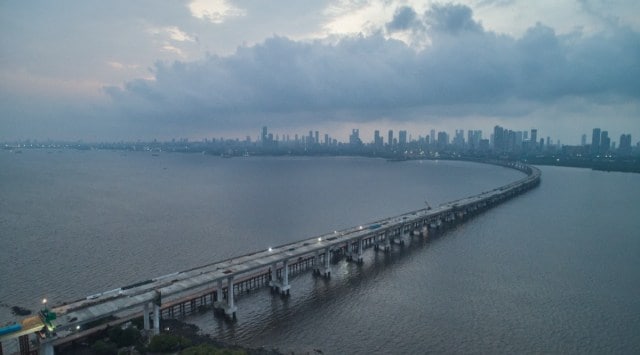Stay updated with the latest - Click here to follow us on Instagram
MTHL: Modern bridge technology used to overcome challenges at sea
Country's longest sea bridge to come up, connecting Mumbai & Navi Mumbai, reducing travel time & saving fuel and energy.
 (Express photo)
(Express photo) To construct the country’s longest sea bridge connecting Mumbai and Navi Mumbai, which is currently under construction and targeted to be opened to traffic by December 2023, the Mumbai Metropolitan Region Development Authority (MMRDA), which is the project implementing authority, is using modern bridge technology to overcome challenges in the sea.
The modern bridge technology includes: Reverse circulation drilling (RCD) piling, Orthotropic steel deck (OSD) bridge girders, wind tunnel testing for OSD bridge design, tuned mass dampers (TMDs) for OSD bridges, full-scale vehicle impact testing for new crash barrier design, and seismic hazard analysis for design.
About Orthotropic Steel Deck (OSD) Construction at MTHL:
• The Orthotropic Steel Deck is a Steel Deck Superstructure (strengthened or stiffened both transversely and longitudinally), which will carry the vehicular load more efficiently among three planes and improve the load-carrying capacity of the bridge as compared to a Concrete Superstructure for a similar span.
• OSD Steel Deck Superstructure has lesser self-weight than concrete or composite girders and a longer span of 180 metre has been designed using OSD for this project by the Contractor (L&T-IHI Consortium).
• OSD is the ideal solution considering MTHL site conditions (Navigational Channels, Discharge Channels) and longer Pier to Pier distances. It is also more cost-effective compared to Cable Stay or Suspension bridges.

• The steel spans are fabricated in fabrication workshop facilities located in Japan, Vietnam, and Taiwan, among others, and delivered to India which will enable faster construction work and lessen deck-related on-site activities.
A barge, which was specifically designed and manufactured, is being used for the transportation of these heavy Orthotropic Steel Deck (OSD) sections.
• This is a flat-top ballast barge having a weight of 5,359 MT with 110 metre in length and 64 metre in breadth, equivalent to the size of an actual football ground area. The depth of the barge is 6 metre with a deck strength of 15 T/m2 (Tonne Per Meter Cube).
Other Challenges:
• Pile boring in Hard Rock up to 47 metre depth with stringent environmental protection measures in mud flats and marine areas
• Working with community: Redesigning of Access Bridge to facilitate movement of Fisherman boats
• Limited time availability for load out of materials to Marine works because of low draft conditions at Jetties
• Working near an operational Pirpau jetty and over subsurface oil pipelines
• Erected India’s Largest (180 metre) and Heaviest (2,565 Metric Tonne) OSDs
Temporary bridge built for actual bridge construction work:
A temporary access bridge of about 4 km has been constructed at Package-1 in the tidal variation zone to facilitate the construction of the permanent bridge structure (MTHL). A similar Access bridge is constructed on the Navi Mumbai side also to facilitate the construction of the permanent bridge structure.
As per the CRZ approval obtained for the construction of this project, this Temporary Access bridge is to be dismantled after the completion of the construction of the bridge.
55 Nights Traffic block on Eastern Freeway Till May 23 for steel span girder launch for MTHL:
For the lifting of five steel composite girders spanning over and across the Eastern Freeway at the Sewri interchange location, 55 nights of traffic block on the Eastern Freeway will be implemented till May 23. The block was initiated on December 22. However, these night blocks will not be operated in one go.
During these night blocks, traffic will not be allowed on the Eastern Freeway and so motorists will have to use diversions through roads under the freeway. The night block will be operational from 10 pm to 5 am.
These steel composite girder spans will be connecting the freeway to the MTHL from the cotton green side and Wadala side, respectively. The average weight of each steel span to be lifted is about 85 metric tonne.
Flamingo viewing deck:
After the construction of the MTHL bridge, the kerosene jetty near this bridge can be used to watch flamingos. However, no dedicated or separate deck has been planned as of now, as per the MMRDA.
All about the MTHL bridge:
The Mumbai Trans Harbour Link (MTHL), also popularly known as the Sewri Nhava Sheva Harbour Link, is an under-construction 6-lane bridge (about 22 kilometre long) with about 16.5 km over the sea and about 5.5 km cumulatively on land on either side. The Link has interchanges at Sewri in Central Mumbai, Shivaji Nagar at Mumbai Bay and National Highway (NH)-4 B at Chirle, Navi Mumbai.
The MTHL will feature approach sections, interchanges, an intelligent transport system (ITS) and other amenities required for a sea bridge. The traffic conditions on the stretch will be monitored and managed from the traffic control centre with the help of CCTV cameras and related facilities installed on the stretch.
MTHL project is divided into 4 Packages:
Package -1 is from Sewri 0.00 km to 10.380 km in sea
Package- 2 is from Sewri 10.380 km to 18.189 km in sea
Package-3 is from Sewri 18.187 km to 21.80 km on land
Package-4 Intelligent Transport System on MTHL Bridge
Need of the Project:
The island city has geographical constraints as it is surrounded by water on three sides. An effective way to decongest the city is to facilitate the development of Navi Mumbai and Raigad district. Therefore, the Mumbai Trans Harbour Link was planned to improve connectivity between the Island city and Navi Mumbai, thereby facilitating the development of Navi Mumbai and Raigad.
The link will provide faster connectivity to the upcoming new international airport, the Mumbai-Pune Expressway, Mumbai-Pune Road (NH-4), the Mumbai-Goa Highway and the Alibaug-Virar Multi-Modal Corridor.
The link will also provide faster connectivity between the Mumbai Port and the Jawaharlal Nehru Port.
Length of MTHL, project cost and contractors:
Total length: 22 km.
3+3 lane + emergency lane on each carriageway.
Interchanges: Sewri Interchange on the Mumbai side, Shivaji Nagar Interchange & Chirle Interchange on the Navi Mumbai side.
Present Contract Value: Rs 7,637.30 crore
Package-2: DAEWOO E&C – Contract Value: Rs 5,612.61 crore
Package-3: Contract Value: Rs 1,013.79 crore
Package-4: JV of STRABAG Infrastructure & Safety Solutions GmbH & STRABAG AG (Contract Value: Rs 427 Crore)
Construction period: 54 months
Commencement Date: March 23, 2018
Actual contract completion date: September 2022
Extension of Time granted up to September 2023
Total Project Cost: About Rs 17,843 crore
Funding Agency: Japan International Cooperation Agency (JICA)







